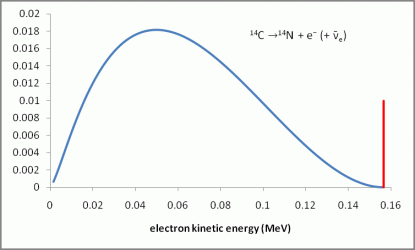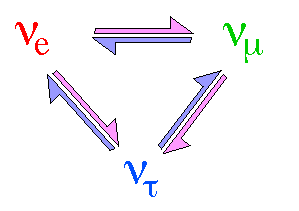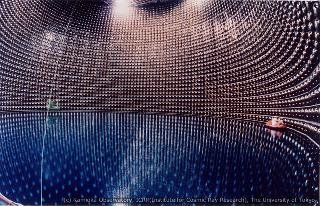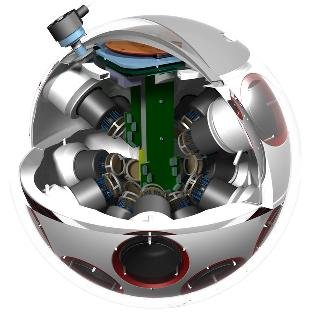The parameters driving the neutrino sector of the Standard Model of particle physics are still not all accurately measured today, and future experiments are designed in order to clarify the situation.

[image credits: ORCA@KM3NET]
Among these, two projects, ORCA (illustrated on the right) and PINGU, aim to extract precisely the mass differences between the three existing species of neutrinos.
This article aims to discuss what are exactly neutrinos, their flavor, and their oscillations.
I will then briefly introduce the PINGU and ORCA experiments, some of their goals and how they work.
THE BIRTH OF THE NEUTRINOS
Physicists were studying, at the beginning of the 20th century, processes where one atomic nucleus A could decay into another atomic nucleus B and an electron e—,
A → B e—
Theoretically, it is very easy to determine the properties of the products of this reaction (B and the electron) thanks to special relativity and energy and momentum conservation. One gets a very important result: the energy of the electron is well determined and has a unique value.

[image credits: the T2K experiment]
This is depicted by the red line on the picture on the left. However, measurements were actually matching the blue curve.
There was a clear mismatch between theory and predictions.
An simple explanation was proposed by Pauli: the electron was allowed to be less energetic because of an extra invisible player taking part to the above reaction.
In this way, the total amount of energy could be shared.
The neutrino (noted by νe) is this guy. In order to match the observation, the neutrino has to be very light. It was actually for a very long time believed massless, until neutrino oscillations (see below) have been discovered in the 20 years ago.
THREE FLAVORS OF NEUTRINOS
However, nature is tricky. We all know that.
I introduced the neutrino as a partner (with respect to the weak interactions) of the electron. This is the reason why there is an index ‘e’ in νe.
But the Standard Model of particle physics contains three copies of the electron: the electron itself, the muon and the tau. The only differences are the masses of these particles, all other properties being the same.

[image credits: Fermilab]
Similarly, the theory includes three species of neutrinos: the electronic neutrino, the muonic neutrino and the tau neutrino.
These three guys are shown on the picture on the right (please ignore the arrows between them for now).
In its original formulation, the Standard Model of particle physics hence includes three neutrino species (also known as flavors), each of them being massless.
NEUTRINO OSCILLATIONS
However, recent neutrino experiments have demonstrated that neutrinos can undergo flavor changes. This is what is known as neutrino oscillations. Those are represented by the arrows on the above picture: a given neutrino can be transformed into another one.
The fact that neutrinos oscillate into each other has deep consequences.
First, neutrinos are massive and the theory must thus be revised. There are hence various extensions of the Standard Model embedding neutrino masses, and also extra particles that could be observed in order to push for one or the other option.

[image credits: Fermilab]
Second, this also means that neutrinos can be seen as chameleons. When propagating in space or interacting with other particles, a neutrino of a given type can turn into a neutrino of another type.
More precisely, the physical neutrinos (the three chameleons on the image) are not of a unique flavor but are instead admixtures of all three flavors. Each neutrino contains a given amount of each flavor.
On the picture, the three possible flavors (electron, muon and tau) can be seen as the three colors (red, yellow and blue).
What is thus needed experimentally is to measure the properties of these three chameleons. We must hence know the mixing properties of the neutrinos (i.e., which amount of each flavor is contained in each chameleon), and the mass differences between the three guys.
THE EXPERIMENTAL CONTEXT
The mixing pattern of the three neutrinos can be parameterized by three mixing angles: how electron neutrinos mix with muon neutrinos, how electron neutrinos mix with tau neutrinos and how muon neutrinos mix with tau neutrinos.

[image credits: Super-Kamiokande @ KEK]
Those parameters start to be very well cornered by current data, coming from experiment like Super-Kamiokande (shown on the picture on the right).
However, for the mass differences, this is another story. The hierarchy between the three neutrinos (or in other words, the mass ordering of the three chameleons) is even unknown.
This represents one of the main challenges for the future neutrino experiments, and two of them are being designed to improve our knowledge with this respect: ORCA and PINGU.
THE ORCA AND PINGU EXPERIMENTS

[image credits: ORCA @ KM3NeT]
ORCA is an acronym for Oscillation Research with Cosmics in the Abyss. This consists of a neutrino telescope based in sea water, offshore from Toulon in France.
The idea is to study neutrinos created from the interactions of cosmic rays with the atmosphere of the Earth. Those neutrinos then continues to fly towards the ground, and some of them will get into the sea.
Since deep sea water has very good optical properties, the idea behind the ORCA experiment is to use it for precision measurement of the reactions of the neutrinos with sea water, using the Cherenkov light produced by those reactions.

[image credits: PINGU @ IceCube]
The PINGU project has been proposed as an extension of the existing IceCube experiment, located at the South Pole. It is also an acronym standing for Precision IceCube Next Generation Upgrade.
The principle of this project consists of burying here a huge detector (its size is more than 10 cubic kilometers) made of Antarctic ice well below the surface.
The detector includes again optical sensors to observe the Cherenkov light generated by the reactions of the astrophysical neutrinos with Antarctic ice.
TAKE-HOME MESSAGE AND REFERENCES
In this article, I discussed a little bit what are neutrinos.
While neutrinos were initially thought off coming as three different flavors (electron, muon and tau), nature was actually trickier and the three existing neutrinos can be seen as three different admixtures of these three flavors.
One unknown today is the mass hierarchy between the physical neutrinos, and I briefly introduced two future projects aiming to solve this puzzle: ORCA and PINGU.
For more information, I recommend the following references:
- Some general information on neutrinos can be foubnd here and there.
- Information on ORCA is available from here.
- Information on PINGU can be found here
- Some general information about the prospects of PINGU and ORCA can be read from here.
- More information on the weak interactions can be found in this older Steemit article.
